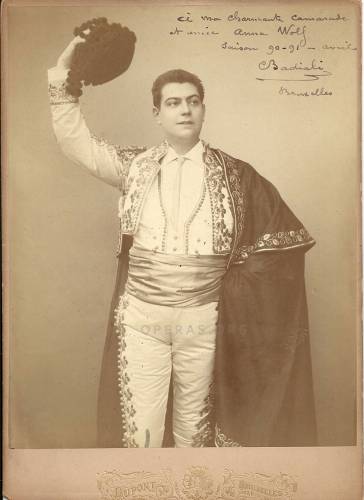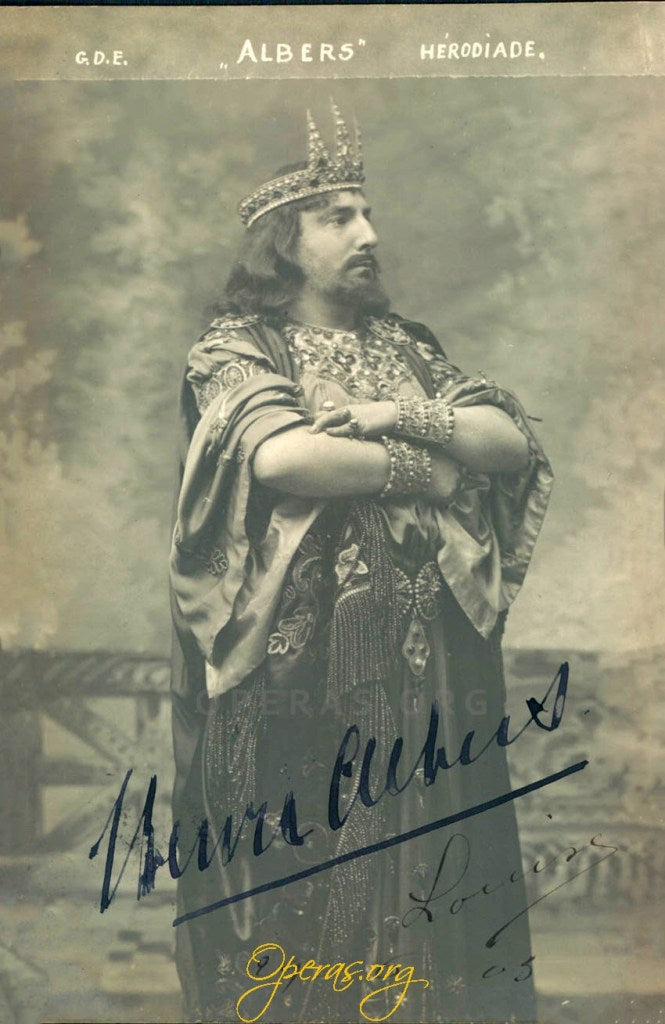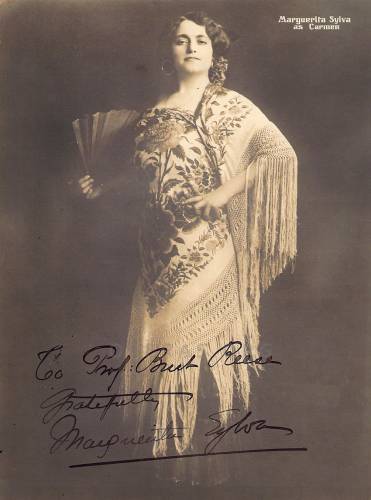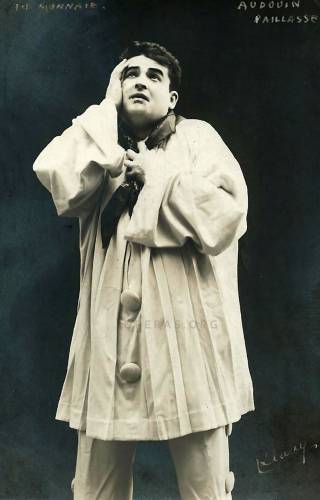Operatic Glories from the Opera-Comique April 15 2021
What is “Opéra Comique”? It is a French “musical genre” alternating sung passages with spoken sections, as opposed to opera, which is entirely sung (e.g. “Carmen” vs. “Tosca”).
It is also a theater in Paris. From its humble inception through a royal decree by King Louis XIV (1714), to its many designations and locations, the Opéra-Comique experienced turbulent times. Two devastating fires destroyed it in 1838 and again in 1887 during a performance of Mignon. The current Opéra-Comique was erected in 1898 on Place Boieldieu. Countless singers performed there in historic performances. Take a look…!
1 – Period engraving of the Opéra-Comique or second Salle Favart in its full glory in 1864
Following the fire of 1838, a new house was inaugurated in 1840 until another ghastly blaze destroyed the theatre again in 1887, killing 84 people. The existing Opéra-Comique was inaugurated in 1898 with a capacity of 1,255 seats.
Period engraving of the Opéra-Comique
2 – French composer Jules Massenet’s historic piece of ephemera from the second 1887 fire
Jules Massenet (1842-1912) was one of Opéra-Comique’s most beloved composers. These fragments of the boxes’ wallpapers with annotations in his hand are one-of-a-kind relics from his own collection!
French composer Jules Massenet’s historic piece of wallpaper from the Opera-Comique – signed.
3 – French tenor Gilbert Duprez (1806-1896) and daughter soprano Caroline Duprez (1832-1875) posing together in a 19th century print, ca. 1851
Duprez was the creator of many roles and invented the tenor’s chest voice high C.
Caroline was gifted with an agile but diminutive voice and studied with her father. Like Marguerite Gauthier and Violetta in “La Traviata”, she died of tuberculosis, aged 43.

4 – French soprano Caroline Miolan-Carvalho (1827-1895) for Parisian weekly “Camées artistiques”, posing as an “ingénue” Marguerite (“Faust”)
A pupil of Gilbert Duprez, she was a coloratura soprano who fiercely negotiated cadenzas and embellishments with composers so that her “vocal fireworks” (her own words) would stun her audience! Married to French baritone and opera director Léon Carvalho.

5 – French bass-baritone Hippolyte Belhomme (1854-1923) as a farcical Biju in Adolphe Adam’s opera « Le Postillon de Longjumeau », Monnaie, Brussels, 1907
A favorite at the Opéra-Comique, he was endowed with a diminutive but alluring presence and a resounding voice. He enjoyed paying funny tricks to his colleagues and as shown here, he had a strong comic talent! He left a recording legacy.

French bass-baritone Hippolyte Belhomme (1854-1923)
Hippolyte Belhomme - The Pretty Maid of Perth (Bizet) - When the flame of l`amour
6 – French soprano Rose Caron (1857-1930) as Elisabeth (“Tannhäuser”), Opéra de Paris, ca. 1885-1886
Following a modest debut and a stint as a chorister, she ruled as a primadonna, esteemed by composers and conductors alike. A respected personality in the Parisian posh circles. Her elegiac figure and acting skills were mesmerizing.
She helped funding the construction of the new Opéra-Comique and left a recording legacy.

Rose Caron - Sigurd (Reyer) - Sigurd
7 – Opéra-comique at its best: French soprano Lise Landouzy (1861-1943) and French tenor Edmond Clément (1867-1928) in “Manon”, Monnaie, Brussels, 1903
The sheer vocal and stylistic splendor of Manon and the Chevalier des Grieux was saluted by the press as “the ideal interpretation of ‘Manon’”, shortly after composer Jules Massenet congratulated the artists in Paris in 1893. Both soloists left a recording legacy.
French soprano Lise Landouzy (1861-1943)
Lise Landouzy - Lakmé (Delibes) - In the forest near us
8 – Australian soprano Dame Nellie Melba (1861-1931) as Ophélie (“Hamlet”), Opéra de Paris, ca. 1890, a role in which she delivered vocal beauty paired with a dazzling technique
Wherever she sang, she was greeted with rave critics, embodying a soprano’s dream come true. Her madness scene in “Hamlet” captured her audience until a ripe age, still sing beautifully the repertoire of her youth! She left a recording legacy.

Nellie Melba - Hamlet (Thomas) - Ophelia's mad szene (1907)
9 – French baritone Charles Badiali (1865-1907) as Escamillo (“Carmen”), in a typical pose, Monnaie, Brussels, 1890-1891
Following a positive debut in Paris in 1889, his voice declined prematurely. His acting skills were considered to be too caricatural as can be seen here.
He later settled in Brussels where his career was almost gone and where he taught singing and acting! He left a recording legacy.

10 – American soprano Sybil Sanderson (1865-1903) as Lucie (“Lucie de Lammermoor”), Opéra-Comique, ca. 1890, a role in which she was dubbed the « Sensational Young American”
Despite her meteoric rise to stardom (she created Massenet’s “Esclarmonde” and “Thaïs”) and privileged relation with composers, her life was not a happy one: poor health and depression wrecked her voice.
She reputedly had an affair with Massenet, and left a recording legacy.

11 – Dutch baritone Henri Albers (1866-1926) in Herodiade (Massenet)
An outstanding baritone, he could learn his part almost photographically in one day in a gallery of more than 140 roles. When his life-size portrait as “Hamlet” by Alfred Bastien was presented to him during an official ceremony at the Monnaie, he fainted, overcome by emotion. He left a recording legacy.

Henri Albers in Herodiade
Henri Albers - Samson et Dalila (Saint-Saens) - Be cursed forever
12 – French bass Marcel Journet (1866-1933) as Méphistophélès (« Faust »), Opéra de Paris, 1931, one of the most memorable “Devils” of his generation…
This distinguished bass scored great successes throughout the world. Belgian tenor Fernand Ansseau (1890-1972) recalled that “his voice was as powerful as an organ”.
A born actor, he could tackle comic and dramatic parts alike, which all gave rise to long standing ovations and encores. He left a recording legacy.

Marcel Journet - Faust (Gounod) - The Golden Calf
13 – French tenor Léon David (1867-1962) as a defiant Don José (« Carmen”), Opéra-Comique, 1905
Born into a musical family, he had a hefty but surprisingly supple lyric voice which was compared to “a violin” by composer and violinist Armand Marsick (1877-1959). An accomplished and refined musician (he had a perfect ear), he became a distinguished voice teacher and author. He left a recording legacy.

David Leon - Carmen (Bizet) - The flower you had thrown me
14 – French tenor Edmond Clément (1867-1928) as a menacing Don José (“Carmen”), Monnaie, Brussels, 1907, a role he sang successfully 180+ times, thanks to his dramatic instinct and handsome look…
Clément exemplified tonal beauty and phrasing, with a voice ideally tailored to opéra-comique, but in New York, his appearances were challenged by those of Enrico Caruso. Wounded during WW1, he reduced his operatic appearances and taught at Nice. He left a recording legacy.

Edmond Clement - The Pearl Fishers (Bizet) - At the bottom of the holy temple (with Journet)
15 – French tenor Thomas-Eustase Salignac (1867-1945) as a pensive Werther, summer lyric season, Ostend, 1908
Hailed as the “intellectual tenor”, his talents were manifold: sculpture and painting, violin, composition, writing, publishing and teaching.
A stern and sometimes distant man, he became an editor and operatic tour impresario, a staunch defender of French opera. He left a recording legacy.

16 – Belgian tenor Laurent Swolfs (1867-1954) as Samson (“Samson et Dalila”), Monnaie, Brussels, 1906, sadly a sign of bad omen for him…
A dramatic tenor, reputed for his instinctive musicality and pathos, singing in five languages. After an illustrious career, he taught in Brussels.
Almost blind, he fell down the stairs of his home and died soon after! Author of an informative autobiography: « Souvenirs de Théâtre et de Coulisses”. He left a recording legacy.

Laurent Swolfs - Serenade (Gounod), sung in Dutch, ca. 1910
17 – French bass André Gresse (1868-1937) as an impressive Osmin in « Die Entführung aus dem Serail », Opéra Comique, 1905
Endowed with an extended voice and an infectious ‘vis comica’, this versatile bass mastered a repertoire of more than 125 roles. A fixture at the Opéra and a respected musical figure, he taught at the Paris Conservatoire, forming many leading singers. He left a recording legacy.

André Gresse - Galatea (Masse), Act I: Pygmalion's aria and scene: The Sad Love
18 – French mezzo-soprano Charlotte Wyns (1868-1917) as “Carmen”, Opéra Comique, on a background note written in shorthand, 1904
An Opéra-Comique top star, she sang with the best artists of her generation and premiered several operas, including “Sapho”. An admired and poignant “Carmen”, she sang Bizet’s opera 220 times! An iconic and beloved Belle-Epoque artist, she left a scarce recording legacy.

Wyns Charlotte - Carmen (Bizet) - Act I: seguidilla By the ramparts of Seville
19 – French soprano Marguerite Carrère-Xanrof (1869-1952) as a regal Marguerite de Valois (« Les Huguenots »), Opéra de Paris, ca. 1892
As the wife of composer Léon Xanrof (1867-1953), she exploited his influential relations to promote her subdued career. Her lovely figure and handsome looks were the talk of the town in Paris as she posed as a fashion model; to her husband’s dismay. She left a recording legacy.

20 – French soprano and actress Georgette Leblanc (1869-1941) as Anita (“La Navarraise”), Nice, 1912 at the center of a dispute over “Mélisande”…
Her companion, Belgian writer Maurice Maeterlinck (1862-1949), author of “Pelléas et Mélisande”, tried to convince Claude Debussy to let her create “Mélisande” in 1902, to no avail: a quarrel ensued and Mary Garden won.
Leblanc’s voice was rather conventional, but she was a remarkable actress. She left a recording legacy.

Georgette Leblanc - Thaïs (Massenet) - Love is a rare virtue
21 – Italian soprano, actress, monologist and beauty queen Lina Cavalieri (1874-1944) as Leoncavallo’s “Zazá” to Raoul Gunsbourg (1860-1955), Saint Petersburg, 1901
A compelling beauty with innate acting skills, a distinctive voice and strong business acumen, her ambition was to become a celebrity beauty queen. Her talents took her to music-hall, operatic and theatrical stages worldwide. She died in the bombing of her house while trying to save her jewelry collection!.

Lina Cavalieri - Manon Lescaut (Puccini) - In quelle trine morbide (1910)
22 – Scottish soprano and seductress Mary Garden (1874-1967) as an eerie Katyusha in Franco Alfano’s “Resurrection”, Chicago Civic Opera, season 1925-1926
The creator of “Pelléas et Mélisande”, she embodied vocal magnificence and refinement, remaining closely associated with “opéra-comique”. Katyusha was a triumph shared with Belgian tenor Fernand Ansseau (1890-1972) as Dimitri. She left a recording legacy.

Mary Garden, Résurrection (Alfano) Dieu de grâce, Victor 1929
23 – French soprano Mariette Mazarin (1874-1952) as Santuzza (“Cavalleria rusticana”), Monnaie, Brussels. The first soprano voice to be ever heard in a radio broadcast in New York, 1910
Of Italian descent, her impassioned temperament was “mesmerizing”. An adopted child, she made her debut aged 17. She created the title-role of “Elektra” with Caruso in America. She ended her life broken, disabled and blind. She left a rare recording legacy.

24 – Paul Bender, German bass and actor (1875-1947) as an ominous Hagen in Richard Wagner’s “Götterdämnerung”, Hofoper, Munich, ca. 1910
A powerful bass and a consummate actor, following his 1914 concert at the Théâtre des Champs-Elysées, critics wrote that “His partners were dismayed by his devil-like histrionic abilities and unearthly expression” (Comoedia).
He later became a revered professor in acting and a mute film actor. He left a recording legacy.

Paul Bender - Der Wanderer
25 – French baritone Jean Bourbon (1875-1948) in the title-role of “The Chemineau” by Xavier Leroux, creation, Monnaie, Brussels, 1908
An underrated singer, he gave thousands of performances and created dozens of operas in realistic and dramatic portrayals. Composer Leroux said that he was his “best Chemineau”.

26 – French contralto Marie Delna (1875-1932) as Didon (“Les Troyens à Carthage”), creation at the Opéra-Comique, June 9, 1892. It marked her extraordinary debut, aged 17. Edmond Clément sang the role of Hylas
With her opulent voice and commanding stage presence, she was dubbed the “sensational contralto”. Despite her prestigious international career and after a foray into teaching, she died in poverty, her funeral being paid by her former colleagues of the Opéra.

Marie Delna - The Trojans at Carthage (Berlioz) - Dear Tire (1912)
27 – Belgian soprano Claire Friché (1875-1968) as « Salomé », Monnaie, Brussels, 1909. The complex and pervert character of Salomé was not to the liking of the soprano’s well-to-do family and she never sang it
A favorite in Brussels, she was asked to “never attempt such an outrageous role again”! She later moved to Paris, where she became a highly esteemed artist of the Opéra-Comique and where she created many roles. She left a scarce recording legacy.

28 – Belgian mezzo-soprano and actress Marguerite Sylva (1875-1957). From “Carmen” to Broadway and Hollywood…
Her life wife was a fairy tale come true. From the Opéra-Comique to the Drury Lane Theater and Broadway musicals, she was an amazing stage performer, actress and singer, who quickly became a household name. She crashed her car into a house driving at full speed and died short after, left a recording legacy.

Marguerite Sylva - Carmen (Bizet) - Act I: seguidilla By the ramparts of Seville
29 – François Darmel (aka Arthur François), Belgian baritone and tenor (1879-1944) as “Parsifal”, creation, Monnaie, Brussels, 1914
French tenor Léon Campagnola (1875-1955) heard him rehearsing in his dressing room in 1909 and was impressed enough to encourage him to switch to tenor. Following his advice and scored great successes in dramatic parts. He left a scarce recording legacy.

30 – Belgian baritone Leopold Roosen (1879-1965) as Méphistophélès (“Faust”), Opéra de Paris, August 18, 1922
A rather elusive artist, he was a talented comedian-singer, paying careful attention to his stage appearance, as can be seen here. He abandoned his career due to ill-health and became an esteemed director of the Royal French Opera in The Hague, proposing a roster of first-class artists. He left a scarce recording legacy.

31 – French soprano Suzanne Cesbron-Viseur (1879-1967) in Jules Massenet´s "Ariane", a role she rehearsed with the composer
A stylish lady, she was one of the most distinguished ambassadors of French opera, and a close friend of many composers. A delicate and intuitive soprano, she was also an exceptional concert soloist.
She became a respected professor and taught singers such as Germaine Lubin and Régine Crespin, etc.), left a recording legacy.

Suzanne Cesbron-Viseur - Sappho (Massenet) - For a year I was your wife (1929)
32 – Russian dancer and soprano Maria Kousnezoff (1880-1966) as “Manon”: from grandeur to decadence…
An immensely talented artist, born into an artistic family, she enjoyed an enviable international career then settled in Paris, where she promoted Russian music and taught acting and singing. Alas, her fortune vanished, ending her life sadly. She left a recording legacy.

Maria Kousnezoff - La Boheme (Puccini) - Mi chiamano Mimi
33 – Elusive French tenor David Devriès (1881-1936) as Jean in Massenet’s “Le Jongleur de Notre-Dame”, Monnaie, Brussels, October 14, 1920
Born into a reputed musical family, his career epitomized French vocal refinement with a small, but perfectly placed voice. He was instrumental in helping to persuade Scottish soprano Mary Garden (1874-1967) to sing the tenor part of Jean at the Metropolitan Opera in 1908. He left a recording legacy.

David Devries - The Juggler of Notre Dame (Massenet), Act I: O freedom, my love!
34 – Belgian bass Albert Huberty (1881-1955) as a realistic old Hebrew (“Samson et Dalila”), Opéra de Paris, 1919
A legendary bass, he sang over 3200 performances, from buffo parts, to lyric or dramatic roles. His stentorian voice was considered alarmingly powerful and he could recreate almost any part instantly. However, as a professor, he simply sat at the piano, and sang …for himself, uncaring towards his pupils! He left a recording legacy.

Albert Huberty - Faust (Gounod) - Serenade
35 – French baritone Daniel Vigneau (1881-1970) as Figaro (“Le Barbier de Séville”), Monnaie, Brussels, 1909
Nearly forgotten, he was a distinguished baritone who created many first and secondary roles. He was also a noted concert soloist and with his wife, they entertained a musical salon where composers and musicians met regularly. He was a reputed vocal coach. He left a recording legacy.

36 – Belgian tenor and stage director Octave Dua (1882-1952) as a spirited Beppe (“Pagliacci”), Monnaie, Brussels, 1909 … Size does not always matter!
A diminutive tenor from Belgium, he primarily sang secondary roles. Noted for his convincing acting and musical preparedness, he created many operas in Europe, the U.S. and in South America, where he was a star. On his return to his native Belgium, he performed cameo parts and became a valued stage director. He left a recording legacy.

37 – French tenor Paul Razavet (1882-1958) as George Brown (“La Dame blanche”), Opéra-Comique, Paris, two years after being wounded during WWI
Courage describes this tenor who, serving his fatherland as an infantry officer, used his ringing and flexible voice to lift up the morale of his fellow soldiers on the battlefield, organizing chamber music concerts! He scored a major success in light to lyric roles. He left a recording legacy.

38 – French tenor Eric Audouin (1884-1949) as Canio (“Paillasse” or “Pagliacci”), Monnaie, Brussels, 1911, a characterization which was greeted as “impressive”
An accomplished tenor, he sang a wide repertoire including Italian opera in which he displayed a dark but ringing voice, coupled with a commanding stage presence. He established a singing academy in Brussels and later, taught in Paris. He left a rare recording legacy.

39 – French baritone Léon Ponzio (1884-1947) as a striking Bruno, creation of “Oudelette”, opera by Charles Radoux, Monnaie, Brussels, April 21, 1912
Of Italian descent, gifted with a warm and powerful voice, he was the quintessential singing comedian in a repertoire encompassing more than 150 roles. He was also a talented painter and graphic designer, before devoting his time to teaching. He left a recording legacy.

Leon Ponzio - The Song of the Desert (Romberg) - Song of the desert, ca. 1930
40 – Nysa Bladel, Belgian soprano (1885-d.) as “Salomé”, holding the head of John the Baptist, Royal French Opera, The Hague, 1925
A distinguished soprano, she was a triumphant wicked “Salomé”. During an audition for the role at Monte-Carlo, a puzzled director Raoul Gunsbourg (1860-1955) suggested that “her stage props are avoided” in order not “to offend the audience’s ‘grand bourgeois’ puritan morality”: she did not!.

41 – French baritone Emile Colonne (1885-1970) as Papageno (“Die Zauberflöte”), Opéra de Paris and Monnaie, Brussels
Following a successful career in France, this dapper and big-voiced baritone became a fixture at the Monnaie. His repertoire consisted of opéra-comique, opera buffa, opera, grand opera and operetta! His Papageno at the Opéra de Paris was saluted by the press as “a stunning and realistic re-creation”. He left a recording legacy.

42 – French soprano Lucyle Panis (1887-1966) as Maliella in Wolf-Ferrari’s “I Gioelli della Madonna”, creation, Monnaie, Brussels, 1913
42 – French soprano Lucyle Panis (1887-1966) as Maliella in Wolf-Ferrari’s “I Gioelli della Madonna”, creation, Monnaie, Brussels, 1913.
She was famous for her beauty and commanding stage deportment. Her “shapely figure” was praised as much as her voice! Her performance of “Thaïs” at the Opéra Comique in 1921 was considered to be “too provocative”… She left a recording legacy.

43 – Belgian soprano Fanny Heldy (1888-1973) as “Obéron”, creation, Monnaie, Brussels, 1911. At the outbreak of WW1, she moved to Paris and became the reigning prima donna of the Opéra de Paris
Her flawless voice and stylish technique can be heard on recordings. Once married to a wealthy French industrialist, she contemptuously forgot her humble Belgian origins and became a French citizen, rarely singing again in her homeland.

Fanny Heldy - Louise (Charpentier) - Since the day (1929)
44 – Belgian tenor Alfred Legrand (1888-1982) as “Mârouf, savetier du Caire”, Théâtre de la Gaîté-Lyrique, Paris, 1919 and a strange encounter with soprano Aline Vallandri
He remains closely associated with opéra-comique, especially in romantic roles. After a performance of “Mârouf” in Paris, his taxi bumped into another car driven by French soprano Aline Vallandri (1878-1952)! They became friends ever since. He left a scarce recording legacy.

45 – The indomitable Belgian contralto Jeanne Montfort (1889-1964) as a plump and vigorous Dalila (“Samson et Dalila”) her debut role at the Opéra de Paris in 1921
Endowed with what she herself described as “a voice from the Gods”, she sang a variety of contralto and alto roles, before embarking on a successful teaching journey in Paris. She reportedly had a private affair with a reputed lady fashion designer … She left a recording legacy.

Jeanne Montfort - Samson et Dalila (Saint-Saens) - My heart opens to your voice (1930)
46 – Belgian tenor Fernand Ansseau (1890-1972) as Orphée (« Orphée et Eurydice »), Monnaie, Brussels, 1922. On October 11, 1921, he created the revised tenor version at the Opéra-Comique to huge acclaim
A pupil of Désiré Demest and Ernest Van Dyck, he was one of the most sought after tenors of his generation who cut short his career at its peak in 1940 at the outbreak of WW2 just after German invasion to devote himself to fishing, archery, “pétanque” (boules) and to teaching. He left a recording legacy.

Fernand Ansseau - Orpheus and Eurydice (Gluck) - J`ai lost my Eurydice
47 – Belgian soprano Emma Luart (1892-1968) as the Queen in Samuel-Rousseau’s opéra-comique « Le bon Roi Dagobert », Opéra-Comique, 1920
With her brilliant voice, distinctive musicality and stylish looks, she was dubbed “the perfect voice” and “La Luart” by her aficionados. Her histrionic abilities were also greeted as “incredibly convincing”.
One of Opéra-Comique’s most beloved artists, she left a recording legacy.

Emma Luart - Thaïs (Massenet) - L`amour is a rare virtue (1928)
48 – Enigmatic French soprano Jeanne Bonavia (1894-1938) as Floria Tosca, Opéra Comique, 1929
Little is known of this soprano of Maltese descent who created the world premiere of “Turandot” in French (Brussels, 1926), except that she had a large dark voice and an electrifying stage presence.
She died prematurely in Nice, due to seafood poisoning after a performance of “Tannhäuser”. She left no known recording legacy.

49 – French baritone and stage director José Beckmans (1897-1987) as Lothario (“Mignon”), Bordeaux, 1923
Of Belgian descent, his international career was astonishing. A talented comedian, his large voice was ideally suited for dramatic parts and he created 55 operas and sang 170 roles! An astute manager, he founded an opera company and eventually became a stage director in Paris and in his hometown, Liège. He left a recording legacy.

José Beckmans - Carmen (Bizet) - Air Toréador
50 – French tenor Georges Thill (1897-1984) at home, rehearsing at the piano, Paris, 1930. His golden-toned voice and commanding presence were unmatched
Unarguably the most perfect lyric tenor voice of the 20th century and a sense of self-esteem commensurate with his talent. He always wanted to “have it his own way”, causing heated reactions among conductors and colleagues. He left a recording legacy.

Georges Thill - Manon (Massenet) - Ah! Flee, sweet picture!
Curated and written by Claude-Pascal Perna
SEE ALSO:
or return to HOMEPAGE
Interested in authentic autographs?
SIGN UP for TAMINO AUTOGRAPHS NEWSLETTER



